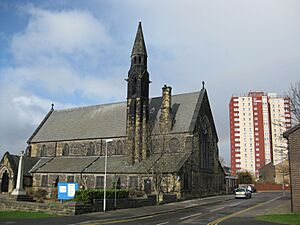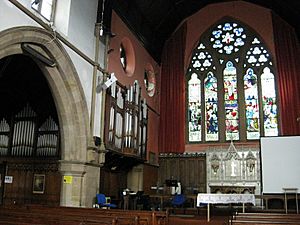St Agnes' Church, Burmantofts facts for kids
Quick facts for kids St. Agnes' Church |
|
|---|---|
| Church of Saint Agnes | |
 |
|
| 53°48′17.8″N 1°31′02.7″W / 53.804944°N 1.517417°W | |
| Location | Burmantofts, Leeds |
| Country | England |
| Denomination | Church of England |
| History | |
| Status | Parish Church |
| Architecture | |
| Heritage designation | Grade II listed building |
| Style | Gothic Revival |
| Groundbreaking | 1886 |
| Completed | 1887 |
| Specifications | |
| Materials | coursed stone with ashlar dressings |
| Administration | |
| Parish | Burmantofts |
| Archdeaconry | Leeds |
| Diocese | Leeds |
| Province | York |
St. Agnes' Church is a special church located in Burmantofts, Leeds, England. It's an active Anglican parish church, which means it's part of the Church of England and serves the local community.
History of St. Agnes' Church
This church was built a long time ago, between 1886 and 1887. It was designed by architects named Kelly and Birchall from Leeds. Later, some changes were made by Lord Grimthorpe.
Architectural Style and Features
St. Agnes' Church is built in a style called Gothic Revival. This means it looks like churches from the medieval Gothic period, but it was built much later. The church is made of stone with special carved stone details. It has a steep slate roof.
Inside, the main part of the church, called the nave, has four sections with eight-sided pillars. A special decorative screen behind the altar, called a reredos, was added in 1891. It's made from colorful tiles from Burmantofts Pottery.
There's also a special memorial near the west window. It's made of terracotta and remembers James Holroyd (1839–1890). He was the person who started the Burmantofts Faience Works, which made the tiles for the reredos. His employees put up this memorial to honor him.
More About Leeds Churches


